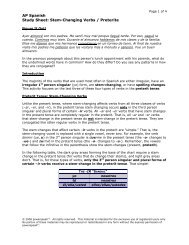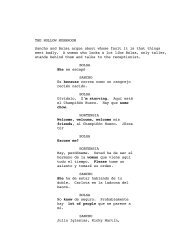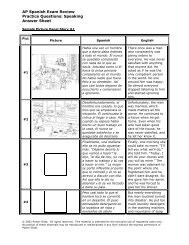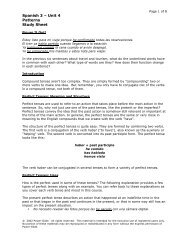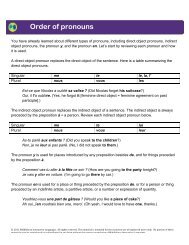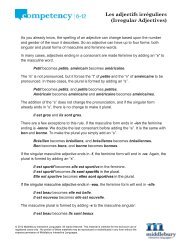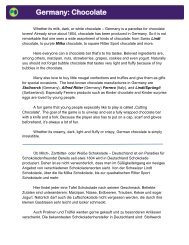Spanish 3 – Unit 2, Lesson 8 Patterns Study Sheet
Spanish 3 – Unit 2, Lesson 8 Patterns Study Sheet
Spanish 3 – Unit 2, Lesson 8 Patterns Study Sheet
You also want an ePaper? Increase the reach of your titles
YUMPU automatically turns print PDFs into web optimized ePapers that Google loves.
<strong>Spanish</strong> 3 <strong>–</strong> <strong>Unit</strong> 2, <strong>Lesson</strong> 8<br />
<strong>Patterns</strong><br />
<strong>Study</strong> <strong>Sheet</strong><br />
Page 3 of 5<br />
You should note that you CANNOT use a demonstrative pronoun without having previously<br />
named the noun that it is replacing or unless it is clear in the context. Otherwise, no one<br />
will understand what object you are referring to.<br />
Demonstrative Pronoun Practice Exercise: Answer with the appropriate pronoun.<br />
1. --¿Quiere Ud. comprar esta falda? --No, gracias. Prefiero “that one.”<br />
2. --¿Te gustan esos zapatos? --Sí, me gustan “those.”<br />
3. --Prefieres este abrigo o ése? --Prefiero “this one.”<br />
4. --¿Qué tienda te gusta más? --“This one,” la joyería, por supuesto.<br />
Now, scroll down and check your answers.<br />
1. ésa <strong>–</strong> that one, The accent replaces falda.<br />
2. ésos -- those, the accent replaces zapatos.<br />
3. éste <strong>–</strong> this one, the accent replaces abrigo.<br />
4. ésta <strong>–</strong> tienda is the understood noun so “this one” should be feminine.<br />
NEUTER -- Each demonstrative pronoun also has a neuter or neutral form. It is used to<br />
refer to abstract ideas, a previously mentioned statement, or something vague like an<br />
unknown or unidentified object. The neuter pronouns do not change for number or gender,<br />
and they do not have a written accent.<br />
• esto (this idea, this thing)<br />
• eso (that idea, that thing)<br />
• aquello (that idea/thing over there)<br />
¡Esto es importante! This generic idea or concept is important!<br />
¿Qué es eso? What is that? -- the object is unknown<br />
Using Demonstrative Pronouns and Demonstrative Adjectives Together<br />
Demonstrative pronouns and demonstrative adjectives can be used together in the same<br />
sentence. All you have to remember is that they must agree in person, number, and gender<br />
with the noun(s) they replace or modify, and that in order to use a demonstrative pronoun,<br />
you must have previously mentioned the noun that you are replacing. For example:<br />
Estas ciruelas son grandes; ésas son pequeñas.<br />
(These plums is large; that one there is small.)<br />
and<br />
Aquella fruta es amarga, pero ésta es dulce.<br />
(That fruit over there is bitter, but this is sweet.)<br />
© 2006 Power-Glide. All rights reserved. This material is intended for the exclusive use of registered users only.<br />
No portion of these materials may be reproduced or redistributed in any form without the express permission of<br />
Power-Glide.




